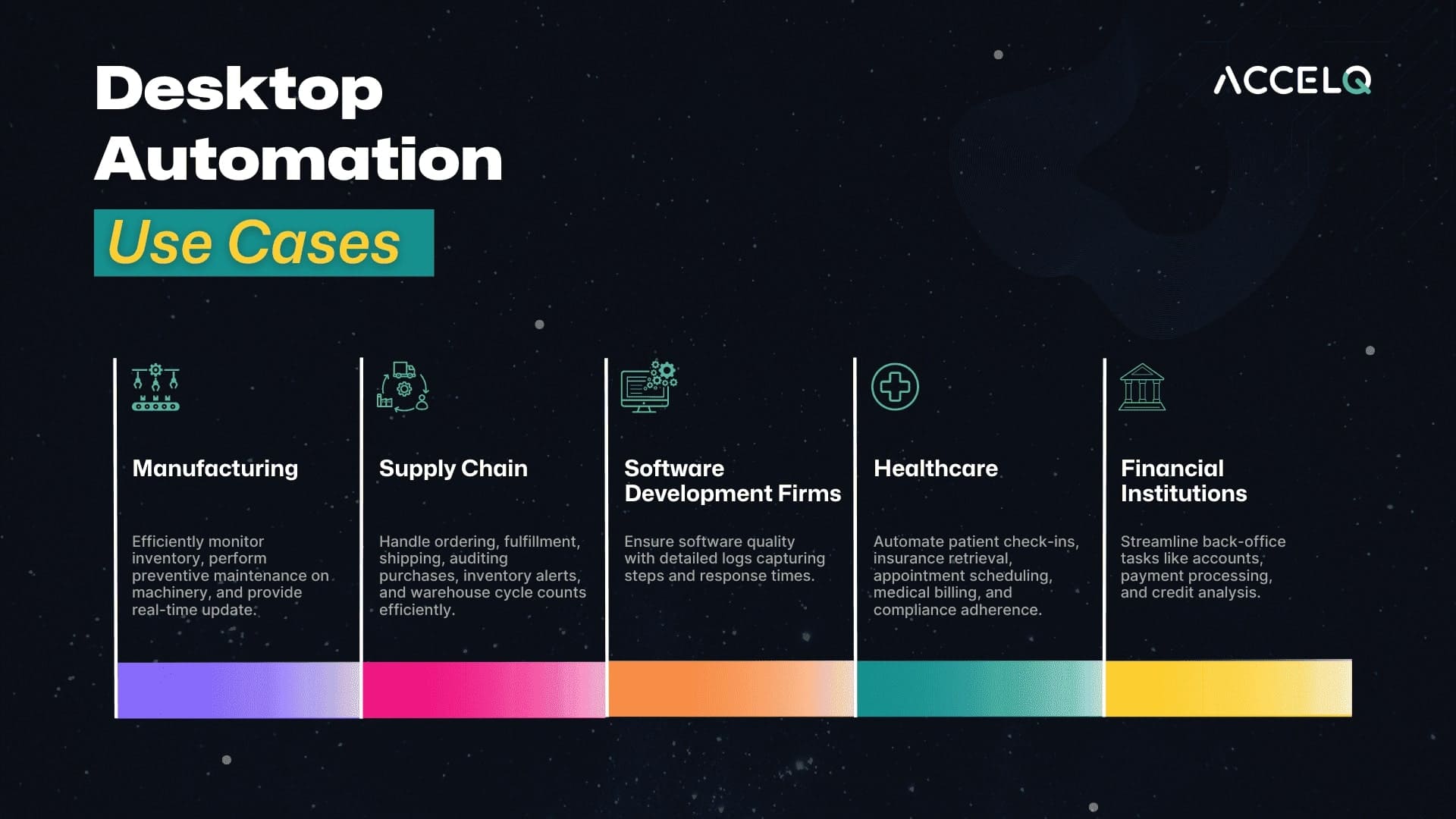What is Desktop Automation? A Brief Guide

Despite the numerous web and cloud-based solutions, desktop applications are essential to organizational operations. However, performing desktop manual testing is time-consuming and energy-consuming. In this scenario, desktop automation became the best solution, and adapting to it can raise productivity and efficiency. Go ahead, you can find everything about desktop automation in this blog.
What is Desktop Automation?
Desktop application automation uses bots programmed to automate repetitive tasks. It specifically focuses on the entire desktop automation process designed for PCs or laptops.
Desktop automation software reduces human-made mistakes and interventions. These bots are devised for accurate and consistently enhanced overall productivity. The technique of Macros and VBA scripts for APIs to automate window-based programs is designed for individual apps and procedures.
SUGGESTED READ - Desktop Application testing vs Website application testing
Why Desktop Automation?
Desktop automation software is important for modern operational processes for its enormous benefits that are offered to firms. Still having manual testing around, inducing automation technologies will speed up productivity, improve accuracy, and be a money saver.
Increase Productivity
Automation always replaces the maximum number of manual standard tasks across desktop applications. While decreasing the time consumed, it speeds up productivity. Bots can typically complete the basic checklist faster than manual intervention. This enables the QA team to work on more strategic tasks by focusing on user experiences and new test methodologies.
Lower the Cost
Automating tasks previously carried out manually will reduce businesses overall production expenses. This will result in an increase in productivity by reducing operations and labor expenses. Companies that use desktop application automation can grow their businesses without hiring more people, which cuts costs and improves the quality of their software generally.
Accuracy and Efficiency
Desktop automation speeds up and improves software development by allowing continuous testing around the clock without human intervention. It ensures that complicated processes that depend on each other run smoothly across many applications and backend systems.
Automation finds problems early, so they don't affect processes further down the line and don't require as many expensive fixes later in production. It also gives uniform test results and makes root cause analysis easier.
Scalability & Flexibility
Desktop automation offers exceptional scalability and flexibility, essential for adapting to evolving business requirements. As organizations grow, this automation seamlessly scales to manage increasing workloads and additional tasks. It integrates effortlessly with existing systems, enhancing workflow efficiency and facilitating adapting business processes to new challenges. This ensures that companies can expand without being hindered by their operational capabilities.
Understanding the Mechanisms of Desktop Automation
Desktop automation enhances the efficiency and speed of processes that involve a user's desktop computer, mouse, or keyboard. Bot scripts can be created using graphical designers or automatically discovering task sequences using AI. Sequences can include actions such as logins, clicks, data copying or pasting, and more. They represent the user's usual steps in completing a series of tasks.
Once deployed, these steps will be executed automatically when a trigger event occurs, such as a data field value, an incoming email, a populated folder, or other specified conditions.
How to do Desktop Automation?
Desktop automation can be achieved by manually inputting or recording desired actions.
Identify processes and tasks to automate
The initial step involves recognizing the potential for streamlining desktop process automation. People often fail to consider this crucial element when implementing an automation strategy, leading to expensive missed chances.
Think about the tasks that frequently occur in a repetitive manner, such as copying and pasting, entering data into fields, and switching between different applications. Collaborating with real users is important to gain insights into the needs and preferences of those who will benefit the most from your desktop automation efforts.
Desktop automation solution
Ensure that you have the appropriate tool in place. Approaching a task without thorough research and thoughtful analysis can undermine the desired outcome. Some Desktop automation tools are created with a specific purpose, while others are designed to be versatile and work across various systems and programming languages.
Experiment and test tools to gain a comprehensive understanding of their capabilities. Complete your assignments: Discover if plug-ins or add-ons are compatible and what the technical specifications entail.
Evaluate efficiency
Understanding how your automated tasks and activities affect your organization is crucial for making informed decisions based on data. To accomplish this, it is necessary to measure and monitor the utilization, efficiency, and impact of automated workflows. Understanding these insights is essential for determining project success or failure and improving automation to achieve even better results.
Desktop Automation Use Cases
Desktop Automation software has the potential to significantly enhance your business's productivity, regardless of its industry. It efficiently automates repetitive tasks and optimizes workflow by eliminating errors.
Manufacturing
Efficient systems can be implemented to monitor inventory and material needs, guaranteeing sufficient staffing and supplies. They can also help with performing preventative maintenance on machinery to avoid downtime and provide real-time updates on any bottlenecks.
Financial Institutions
Desktop automation software provides financial institutions with the advantage of streamlining all their back office tasks, resulting in numerous benefits. As a business manager, it's impressive how bots seamlessly handle tasks such as accounts, payment processing, and credit analysis inspections without the risk of human error. With bots taking care of most transactional tasks, teams can enhance their services and dedicate their attention to exceptional customer service.
Software Development Firms
The use of bots and desktop software automation is essential to ensuring quality in software development firms. Bots provide detailed logs that capture the steps taken and data such as response time to identify issues quickly. Therefore, developers can proactively identify and address any issues or flaws before they arise, thanks to the continuous validation provided by the bot.
Healthcare
Bots within the healthcare industry automate repetitive administrative tasks that consume a significant amount of time. They are proficient in handling patient check-ins, retrieving insurance information, scheduling appointments, processing medical billing, and adhering to compliance requirements. This enables clinicians to allocate more valuable time to patients rather than being consumed by administrative tasks.
Supply Chain
In supply chain firms, bots are utilized to handle ordering, fulfillment, and shipping. As a business manager, bots efficiently handle various tasks such as auditing purchases, sending inventory alerts, placing replenishment orders, tracking shipments, and managing vendor communications. Warehouse robots can also handle cycle counts by ensuring the precise fulfillment of customer orders.
Conclusion
Desktop application automation provides a practical solution for efficiently testing applications deployed across multiple organizations. Automation streamlines repetitive processes, leading to increased output consistency. This allows testers and quality teams to dedicate more time to valuable exploratory work and to enhance the user experience.
Geosley Andrades
Director, Product Evangelist at ACCELQ
Geosley is a Test Automation Evangelist and Community builder at ACCELQ. Being passionate about continuous learning, Geosley helps ACCELQ with innovative solutions to transform test automation to be simpler, more reliable, and sustainable for the real world.
Discover More
 Unified Testing: Uncovering Benefits and Best Practices
Unified Testing: Uncovering Benefits and Best Practices
Unified Testing: Uncovering Benefits and Best Practices
 Cloud Testing Challenges QA Teams Must Solve
Cloud Testing Challenges QA Teams Must Solve


































